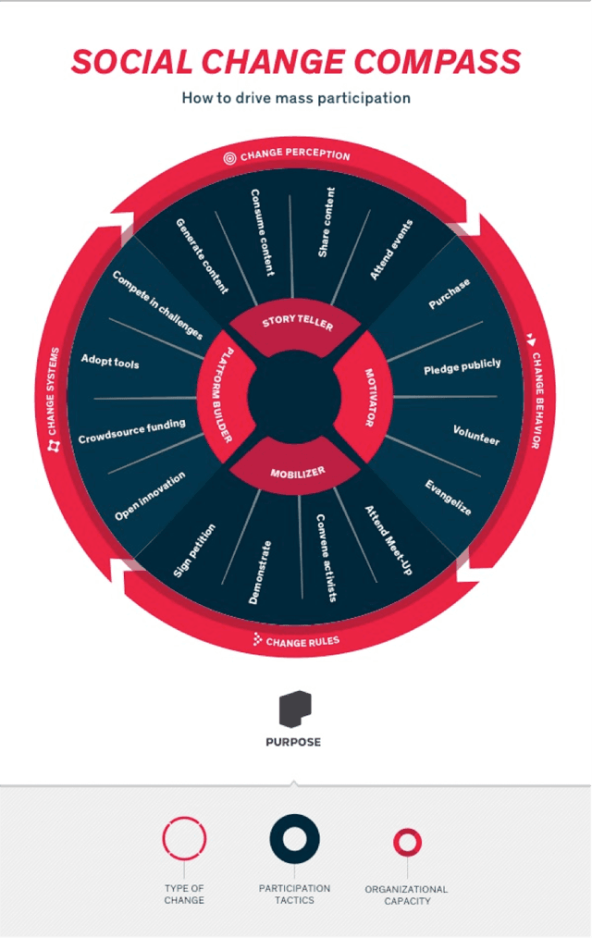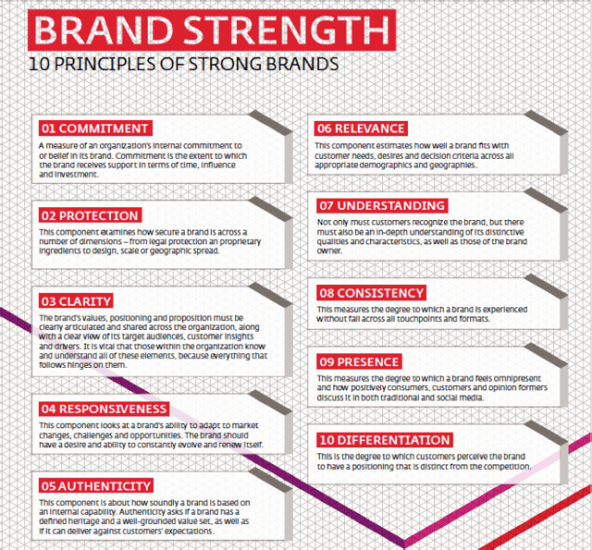The 21st-century consumer has arrived: more informed and ready to take action to improve the world. And just in time. Economic uncertainty, political upheaval, and social unrest are forcing even the most stalwart business leaders to reassess the role of business in society.
At the same time, technology is creating opportunities for people to congregate in numbers never before possible and solve social problems collectively. Brands—the windows between consumers and businesses—are important platforms for organizing and activating this collective potential. Participation is the next stage of brand strategy.
Next-gen purpose-driven brands and corporate citizenship
Consumers are increasingly demanding that brands pursue a social mission and add meaning to our lives. It is no longer enough for brands to claim that they deliver an affordable product responsibly. They must have a point of view on the company’s role in society, and a clear and authentic strategy to engage its consumers around that vision. Millennials relentlessly pursue authenticity and agency; they are more informed, increasingly skeptical of cause marketing, and more engaged. With consumer activism on the rise, this poses significant risks for brands that tell a disingenuous story. It’s not enough to publish a glossy annual CSR report; businesses must understand that consumers want to actively participate with brands in the pursuit of a compelling vision for change.
A platform for meaningful participation and mass social engagement
As mobile and social channels spark innovations and new business models, many mature businesses find themselves in the midst of significant change, if not complete disruption. The tendency of established brands facing market change has been to tighten their grip; they control messaging, choreograph and stage moments of “public engagement,” and avoid open-source campaigns. But pursuing a strategy based on control can compromise a brand’s value and relevance.
Are you enjoying this article? Read more like this, plus SSIR's full archive of content, when you subscribe.
Cultivating a genuine relationship with consumers and demonstrating that your business is truly committed to social impact is critical to staying agile and competitive in an increasingly disruptive environment. But how does a company pursue a strategy that creates business value and delivers on a promise for real, measurable social impact? The answer lies in how it deploys the brand to activate its customers and their communities.
Mass participation drives social change
The Purpose approach to mobilizing mass participation around a social mission builds on a cycle of four types of social change: perception change, behavior change, rules change, and systems change.
Perception change is about shifting personal and societal viewpoints and cultural norms. As perceptions change, awareness increases. With heighted awareness, consumers can internalize a new way of living, change their own behavior, and then begin to convince others to change their behavior. A collective groundswell that aggregates new beliefs and behaviors can then put pressure on levers of power to change the rules surrounding a social issue. And from there, a change of rules can create opportunities to reshape how society operates, resulting in infrastructure and process innovations for organizing our resources and ourselves. In turn, better systems enable us to share information and interact in new ways that have implications for our perceptions and cultural norms.
 Purpose has developed an approach to mobilizing mass participation toward social change that can guide purpose-driven brands.
Purpose has developed an approach to mobilizing mass participation toward social change that can guide purpose-driven brands.
Brands that want to successfully develop and activate a mass participation strategy must answer three important questions:
- What type of social change does the brand seek to produce with the world?
- What tactics does the brand deploy to activate its community (consumers) for change?
- What organizational capacities are required to implement each tactic?
This approach has implications for how brands structure and execute their social change activities. It requires a closer collaboration across departments: sales, marketing, and citizenship/sustainability.
Done well, the benefits for brands are manifold
A purpose-driven participation strategy creates a sense of belonging and forges closer bonds between brands and audiences; it drives choice, legitimacy, and loyalty. It allows a brand to provide meaningful experiences that they can share with friends, families, and peers. Perhaps most importantly, it creates greater social impact faster by tapping the power of networks.
But how and where exactly does this strengthen a brand long-term and at its core?
 Interbrand’s brand strength approach.
Interbrand’s brand strength approach.
A number of these dimensions are especially relevant in our new, purpose-driven world and can be directly influenced by engaging customers with the right tactics.
Here are some examples of how companies have used these principles to strengthen their brands.
How can participation raise awareness for the brand and its defined purpose?

Chipotle aspires to shift society’s eating habits and the structure of our food system by endorsing “Food With Integrity.” It is positioning the brand on the forefront of educating consumers about quality food, responsible sourcing, and transparent supply chains. In 2011, Chipotle launched an animated two-minute movie on YouTube—a compelling story that people could actively share across social media. To date, the movie has gotten more than 7 million views and more than 300 million media impressions. In just two weeks, the Scarecrow video has seen over 6 million views and the game is enriching the customer experience with the brand’s mission. Chipotle is changing how people think about and eat fast food, making the brand highly relevant to a health-conscious audience. Is it paying off economically? An estimated 165-180 new restaurants in 2013 suggest it is. Could customer loyalty be used to build healthier, more sustainable agricultural supply chains? Yes.
How can a participation strategy help set a brand apart from its competitors?

The eyeglass company Warby Parker has defined a unique business model that offers affordable, stylish eyeglasses. Consumers also get the benefit of contributing to a good cause—for every pair a customer buys, Warby Parker donates a pair of eyeglasses to a nonprofit like VisionSpring, which provides glasses to someone in need. Warby Parker hit its first-year sales targets within the first 3 weeks and sold out of its top 15 styles in 4 weeks. To date, it has donated more than 250,000 pairs of glasses. This is a disruptive, mission-driven business model—can Warby Parker customers build a market for affordable eyeglasses worldwide? Yes.

How can activism help raise the external visibility and perception of a brand?

Purpose incubated and launched All Out, a global LGBT movement, in 2011. Today, with 1.7 million members in almost 200 different countries, All Out runs real-time campaigns to inform, educate, and engage the public. During the summer of 2012, in Cameroon, Jean-Claude Roger was sentenced to jail for sending the following text to another man: "I love you very much." In response, All Out launched a user-generated campaign urging members to sign a petition and post images of themselves with the same message Roger sent. The campaign resulted in more than 180,000 petition signatures and sent a signal to Cameroon that the world was watching. How can people use the All Out brand to change perceptions and behaviors that entrench deep inequalities across the globe? Yes.
How can a brand be a platform for social entrepreneurship and innovation?

Virgin Unite has put its values into practice through the Branson Centres for Entrepreneurship in the Caribbean and South Africa, which aim to support entrepreneurs in building sustainable, socially and environmentally conscious, and vibrant local economies. The initiative reflects Virgin Unite’s long-term goal of fostering entrepreneurs to spark change, and ties into Virgin’s desire to create a thriving sustainable tourism industry that supports—not destroys—local communities. As the platform continues to cultivate visionary entrepreneurs, is there a role for consumers to participate and support their success? Yes.
A new social imperative
Brands—the stories they tell and allow us to share—must enable us to use our agency to drive social change. Market disruption, new consumer expectations, and changing behavior patterns always present challenges. Businesses should see consumers’ cry for participation as the long-awaited call for brands to play an even more substantial role in people’s lives. Purpose-driven brands can now wholeheartedly tap into an army of enthusiastic supporters who want to be personally invested in a brand’s social purpose and who will reward those brands that allow them to participate in the journey.
Support SSIR’s coverage of cross-sector solutions to global challenges.
Help us further the reach of innovative ideas. Donate today.
Read more stories by Justin Stokes & Dominik Prinz.

